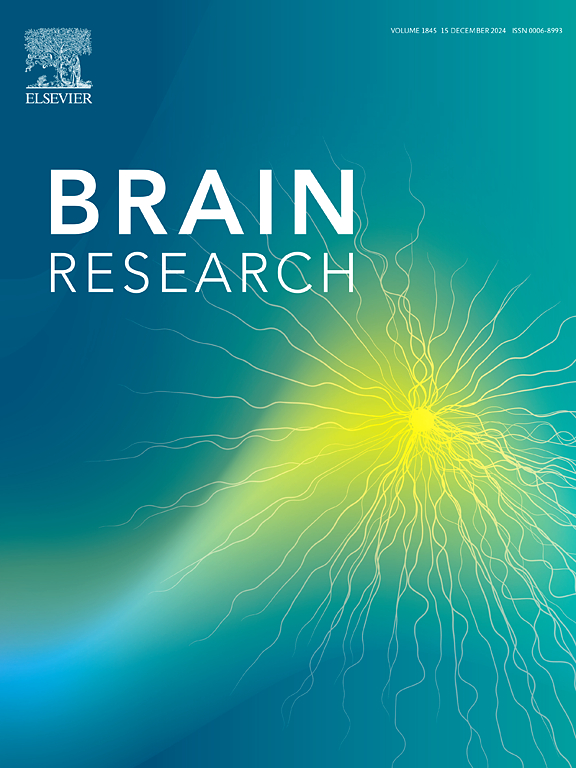IF 2.7
4区 医学
Q3 NEUROSCIENCES
引用次数: 0
摘要
阿尔茨海默病(AD)是导致老年人痴呆的主要原因。淀粉样蛋白-β(Aβ)和 tau 蛋白神经纤维缠结在大脑中累积,导致记忆、思维和行为逐渐衰退。神经炎症和氧化应激在注意力缺失症的发生和发展过程中起着重要作用。研究表明,山竹果皮中的一种化合物α-mangostin (α-MG)可能具有抗炎、抗氧化和保护神经的特性,这可能对注意力缺失症有益。要全面了解α-MG对AD的治疗机制,并确定其作为治疗选择的潜力,还需要进一步的研究。α-MG治疗能明显提高暴露于Aβ的hNSCs的活力,并降低caspase的活性。此外,这种治疗方法还能明显降低 TNF-α 和 IL-1β 的表达。该疗法能有效恢复 Aβ 诱导的 IKK 和 NF-κB (p65) 的表达变化,而这两种物质是炎症反应中的关键因素。此外,α-MG 还能有效降低经 Aβ 处理的 hNSCs 中 iNOS 和 COX-2 的水平,显示出其潜在的治疗功效。α-MG能保护hNSCs免受Aβ诱导的氧化应激,并有效防止Aβ导致的Nrf2水平下降。与 Aβ 处理的对照组相比,α-MG 能明显提高 Nrf2 下游抗氧化靶基因(包括 SOD-1、SOD-2、Gpx1、GSH、过氧化氢酶和 HO-1)的活性和 mRNA 表达量。在 Tau-GFP 表达的 hNSCs 中,α-MG 能明显减少 tau 和泛素(Ub)的聚集,提高蛋白酶体的活性,并增加 HSF1、HSP27、HSP70 和 HSP90 的 mRNA 表达量。这项研究大大提高了我们对α-MG抗炎、抗氧化应激和抗聚集作用的理解。这些发现对开发延缓AD进展和促进健康老化的治疗方法具有潜在的治疗意义。本文章由计算机程序翻译,如有差异,请以英文原文为准。
The α-MG exhibits neuroprotective potential by reducing amyloid beta peptide-induced inflammation, oxidative stress, and tau aggregation in human neural stem cells
Alzheimer’s disease (AD) is the primary cause of dementia in older adults. Amyloid-beta (Aβ) and tau protein neurofibrillary tangles accumulate in the brain, leading to a progressive decline in memory, thinking, and behavior. Neuroinflammation and oxidative stress play a significant role in the development and progression of AD. Research has suggested that α-mangostin (α-MG), a compound found in mangosteen peels, may have anti-inflammatory, antioxidant, and neuroprotective properties, which could be beneficial in the context of AD. Further research is required to fully comprehend the therapeutic mechanisms of α-MG on AD and determine its potential as a treatment option. α-MG treatment significantly improves the viability of hNSCs exposed to Aβ and reduces caspase activity. Furthermore, this treatment is associated with a notable decrease in the expression of TNF-α and IL-1β. The treatment effectively restores alterations in the expression of IKK and NF-κB (p65) induced by Aβ, which are critical factors in the inflammatory response. Moreover, α-MG effectively reduces iNOS and COX-2 levels in Aβ-treated hNSCs, showcasing its potential therapeutic benefits. Treatment with α-MG protects hNSCs against Aβ-induced oxidative stress and effectively prevents the decrease in Nrf2 levels caused by Aβ. The treatment significantly enhances the activity and mRNA expression of Nrf2 downstream antioxidant target genes, including SOD-1, SOD-2, Gpx1, GSH, catalase, and HO-1, compared to Aβ-treated controls. α-MG significantly reduces tau and ubiquitin (Ub) aggregates, enhances proteasome activity, and increases the mRNA expression of HSF1, HSP27, HSP70, and HSP90 in Tau-GFP-expressed hNSCs. This study significantly improves our comprehension of the anti-inflammatory, antioxidative stress, and anti-aggregated effects of α-MG. These findings have potential therapeutic implications for developing treatments that could delay AD progression and promote healthy aging.
求助全文
通过发布文献求助,成功后即可免费获取论文全文。
去求助
来源期刊

Brain Research
医学-神经科学
CiteScore
5.90
自引率
3.40%
发文量
268
审稿时长
47 days
期刊介绍:
An international multidisciplinary journal devoted to fundamental research in the brain sciences.
Brain Research publishes papers reporting interdisciplinary investigations of nervous system structure and function that are of general interest to the international community of neuroscientists. As is evident from the journals name, its scope is broad, ranging from cellular and molecular studies through systems neuroscience, cognition and disease. Invited reviews are also published; suggestions for and inquiries about potential reviews are welcomed.
With the appearance of the final issue of the 2011 subscription, Vol. 67/1-2 (24 June 2011), Brain Research Reviews has ceased publication as a distinct journal separate from Brain Research. Review articles accepted for Brain Research are now published in that journal.
 求助内容:
求助内容: 应助结果提醒方式:
应助结果提醒方式:


